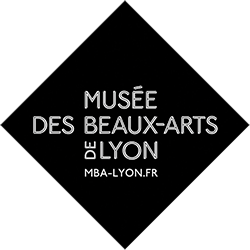From cloister to garden
Did you know ?
The museum is housed in a former 17th-century abbey. The garden used to be a cloister with a central pool, orange and yew trees, exotic potted plants and sculptures. Only the abbey's nuns had access to this enclosed space.
After the French Revolution and the departure of the nuns, the museum was created and the cloister became opened to the public. At that time, fragments of ancient architecture were displayed under the arcades. These are now housed at Lugdunum - Roman Museum and Theaters.
The garden was first redeveloped in 1832. On the terraces, a stone balustrade adorned with decorative vases replaced a wrought-iron fence. Casts of ancient Greek friezes from the Parthenon in Athens and the Nereides Monument in Xanthos were placed above the arcades.
Architect Abraham Hirsch (1828-1913) restructured the garden between 1879 and 1883. Painter Louis Bardey (1851-1915) decorated the vaults of the galleries. Above the arcades, mosaics depict famous Lyonnais artists. The niches house plaster copies of famous antique statues.
Garden trees
Take a stroll through the garden and discover seven different tree species.
Can you recognize them?
A. Small-leaved lime (Tilia cordata)
B. Chinese pear (Pyrus calleryana)
C. Downy birch (Betula alba)
D. Cherry plum (Prunus cerasifera « Feketeana »)
E. Pedunculate oak (Quercus robur)
F. Provence hackberry (Celtis australis)
Plaster copies after the antique
1. Venus Genitrix
2. Discobolus at Rest
3. Capitol Aphrodite
4. Diane of Gabies
5. Satyr
6. Ephebe
7. Venus Medici
8. Capitol Antinous
9. Apollo, copy after the Medici Apollino, 1910, bronze
All around the cloister: Plaster casts after the friezes from the Parthenon in Athens and the Nereid Monument in Xanthos
Bronze medallions (1883)
Look up to discover portraits of twelve famous Lyonnais artists, some of whom produced works in the museum’s collections.
North (left to right)
10. Charles Textor, Antoine Berjon (1754-1843), painter
11. Étienne Pagny, Guillaume Coustou (1677-1746), sculptor
12. Étienne Pagny, Philibert de l’Orme (1506-1577), architect
13. Étienne Pagny, Jacques Stella (1596-1647), painter
14. Charles Textor, Gérard Audran (1640-1703), engraver
West
15. Pierre Aubert, François Lemot (1772-1827), sculptor
South (left to right)
16. André Delorme, Pierre Drevet (1664-1738), engraver
17. Joseph Fabisch, Hippolyte Flandrin (1809-1864), painter
18. Joseph Fabisch, Antoine Coysevox (1640-1720), sculptor
19. Joseph Fabisch, Simon Saint-Jean (1808-1860), painter
20. André Delorme, Jean Jacques de Boissieu (1736-1810), painter and engraver
East
21. Pierre Aubert, Simon Maupin (1598-1668), architect
Photo credits :
1 à 8 : images © Lyon MBA – photo Martial Couderette
9 : image © Lyon MBA – photo DR
10 à 21, et frise : images © Lyon MBA – photo Alain Basset
Scultures in the garden, from the 19th to the 21st century
Since the mid-19th century, the museum's garden has featured a collection of original sculptures, tracing a history of sculpture from the 19th to the 21st century. Jean François Legendre-Héral's Giotto tracing a ram's head in the sand (1838-1842) is part of the Neoclassical legacy, while Francisque Duret's Chactas meditating on the tomb of Atala (1836) opens the way to Romanticism. André Delorme's First Attempt (1861-1868), Léon Cugnot's Drunk Faun (1863-1870) and Léon Delhomme's Democritus Meditating on the Soul Location (1868) illustrate the height of classical taste in the mid-19th century.
In the west gallery are three monumental marble works: Castalia (1873-1883) by Eugène Guillaume, Agar (1893-1897) by François Sicard, and Gilliatt and the Octopus (1879-1890) by Émile Joseph Carlier.
Two bronzes by Auguste Rodin introduce modernity into sculpture: Meditation with arms (after 1900), a recent deposit from the Musée Rodin, and above all The Shadow (1902-1904), a major work in the collection, acquired from the artist during his lifetime.
Antoine Bourdelle's Carpeaux at Work (1908-1910) develops an expressionism of form, while Jean Larrivé's Young Athlete (1908) is part of the “retour au style” (“back to style”), an artistic movement of the early 20th century that sought to rediscover the clarity and balance of ancient sculpture, without imitating it.
Two contemporary works are exhibited in the garden: Terra, an invisible work buried in the earth during a performance by artist Claudio Parmiggiani in 1989, and Indeterminate Line by Bernar Venet, installed in 2018 in resonance with an exhibition organized at macLYON.
Sculptures
1. Auguste Rodin, Meditation with Arms, after 1900, bronze
2. Léon Cugnot, Drunk Faun, also said Return from a Feast to Bacchus, 1863-1870, bronze
3. Eugène Guillaume, Castalia, also said Source of Poetry, 1873-1883, marble
4. François Sicard, Agar, 1893-1897, marble
5. Émile Joseph Carlier, Gilliatt ant the Octopus, also said Gilliatt Grabbed by the Octopus, 1879-1890, marble
6. Antoine Bourdelle, Carpeaux at Work, 1908-1910, bronze
7. Francisque Duret, Chactas in Meditation on Atala’s Grave, 1836, bronze
8. Bernar Venet, Indeterminate Line, 1997, patinated steel
9. Claudio Parmiggiani, Terra, 1989, terracotta ball buried in the garden of the Musée des Beaux-Arts
10. André Delorme, First Attempt, also said Flute Player, 1861-1868, bronze
11. Jean François Legendre‑Héral, Giotto tracing on the Sand the Head of a Ram, 1838-1842, bronze
12. Auguste Rodin, The Shadow, 1902-1904, bronze
13. Léon Alexandre Delhomme, Democritus Meditating on the Soul Location, 1868, bronze
14. Jean Larrivé, Young Athlete, also said Athlete putting a Band round his Forehead, 1908, bronze
Photo credits :
1, 7 : images © Lyon MBA – photo Martial Couderette
2 à 6, 10, 11, 13, 14 : images © Lyon MBA – photo Alain Basset
8 : © ADAGP, Paris, 2025. Image © Lyon MBA – photo Antoine Guerrier
9 : Droits réservés. Photo Blaise Adilon
12 : image © Lyon MBA – photo RMN / René-Gabriel Ojéda






